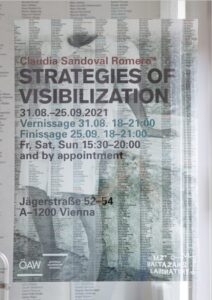Feature 1: claudia sandoval romero*
In “Strategies of Visibilization Searching for Contact Zones between the Periphery and Center in mumok’s Exhibitions, 1998–2018,” claudia sandoval romero* presents a spatial installation, which presents artists who participated in exhibitions at the Museum moderner Kunst Stiftung Ludwig Wien-mumok between 1998 and 2018. This installation focuses on the underrepresentation of women and gender nonconforming (*) artists across the Global North and the Global South. This video below is a digitally narrated version of the spatial experience of the installation, which allows the audience to virtually witness the significance of the role of art collections and exhibitions in not only participating in the continuation of the colonial project of the dominant culture, but also the decolonial potential for art collections and exhibitions in disrupting these practices of silences, absences, and underrepresentation.
“Strategies of Visibilization” (EN) “Estrategias de Visibilización” (ES)
Feature 2: Natalia A. Koutsougera
Natalia A. Koutsougera, in “‘Out in the Streets’: Hip-Hop Narratives in Contemporary Greece“, partially draws on ethnographic fieldwork on rap and hip-hop dance performativities to explore why hip-hop and street cultures are so popular today in Greece. One of the ethnographic fieldwork Koutsougera highlights is the following film, The Girls Are Here (2015). The film showcases multiple aspects of Athens, Greece’s hip-hop culture and street dance scene. Through the friendship between two female hip-hop/street dancers, the film explores the construction of gendered identities and female solidarities within hip-hop/street culture. This spotlights an ongoing process of the role of hip-hop communities in centering the “subversive voices of minority groups” (Koutsougera 2023, p. 221) and challenging political boundaries, traversing race, class, and gender lines.
